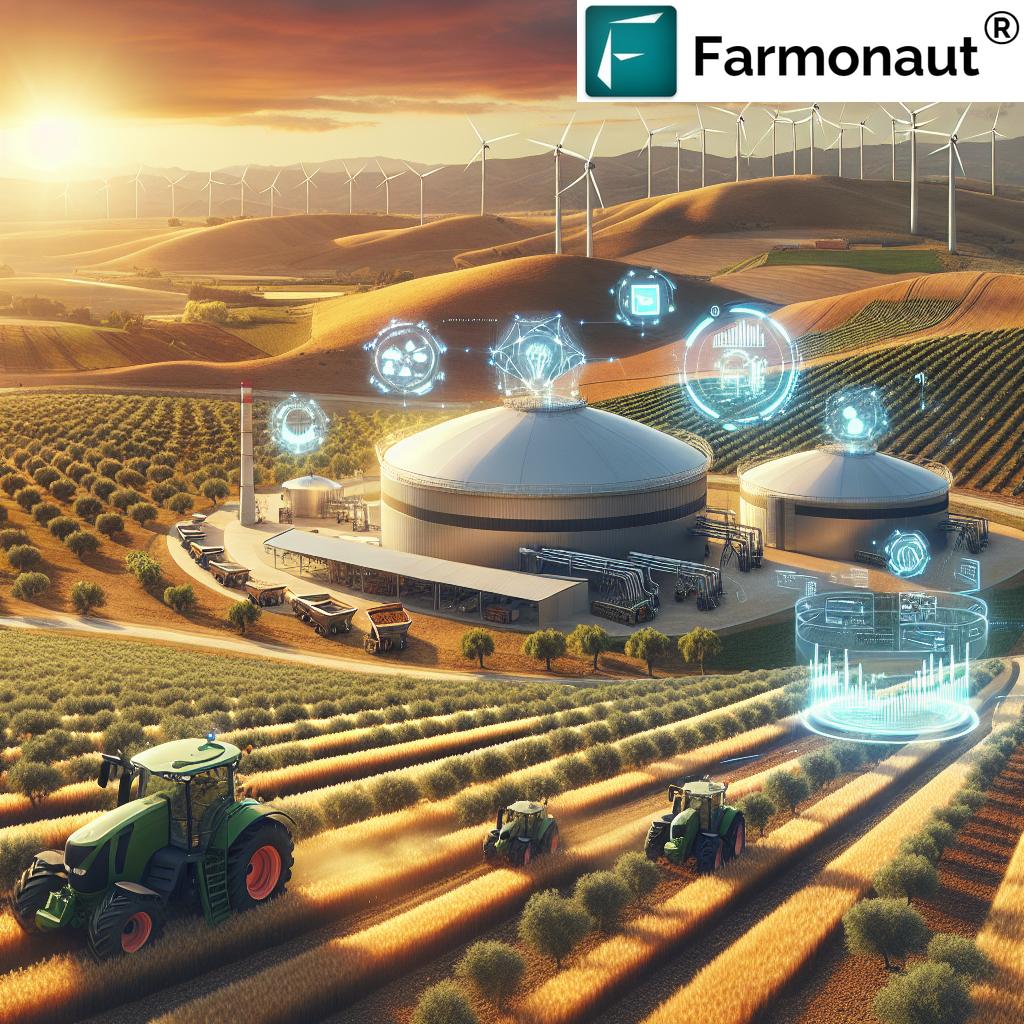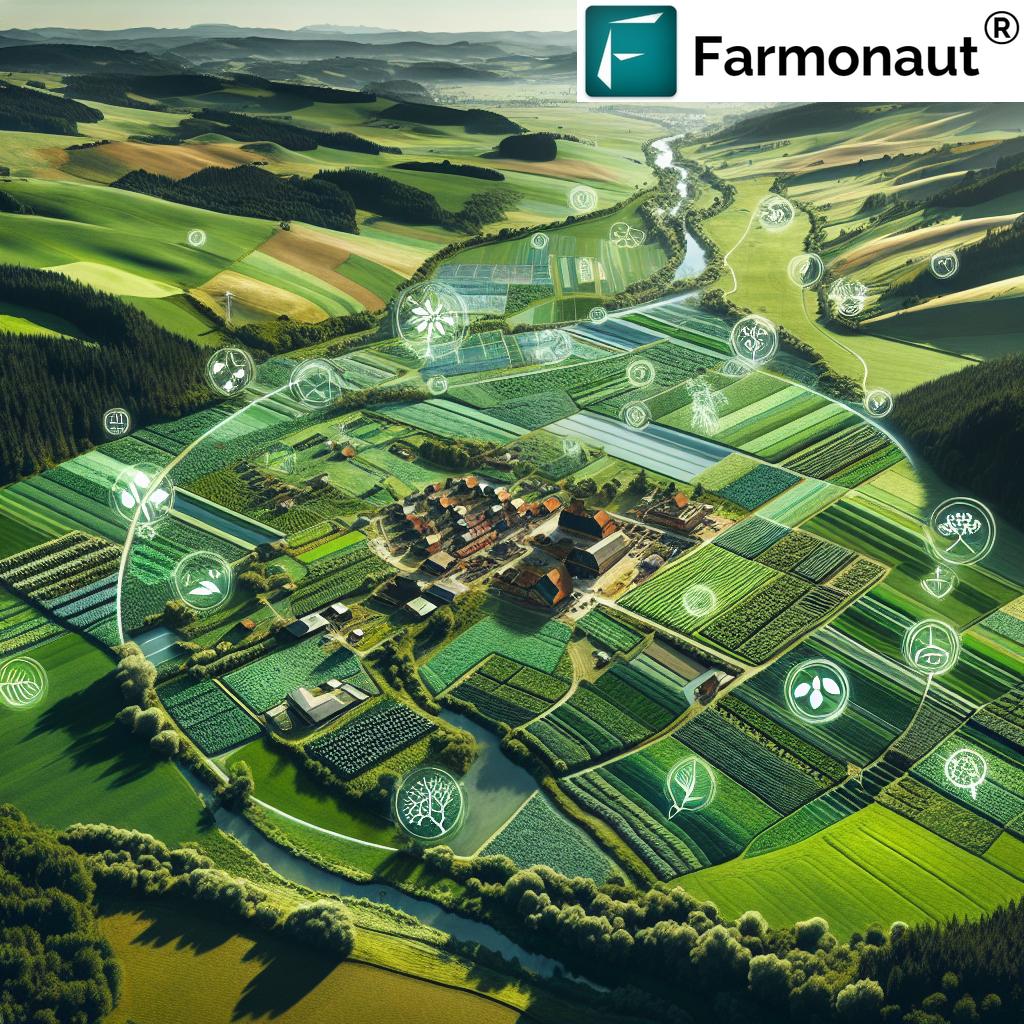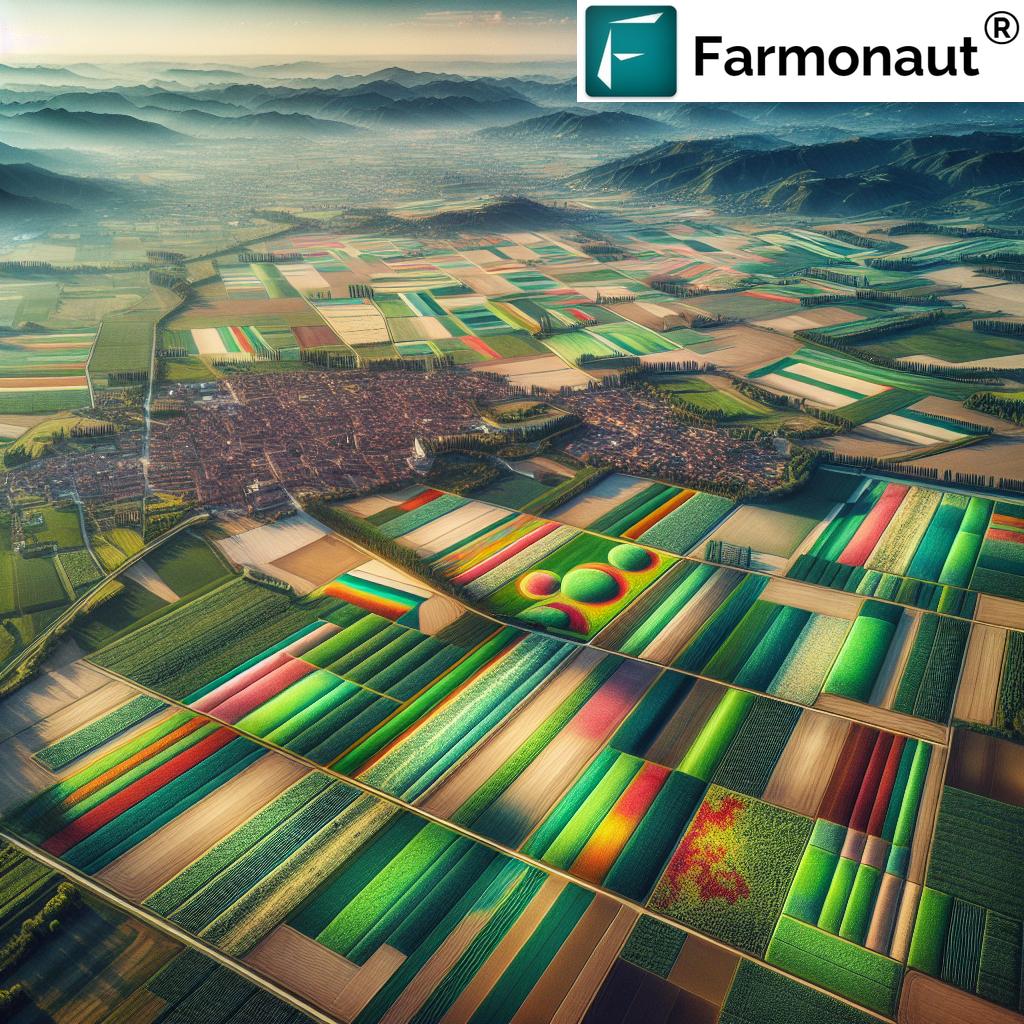Agriculture Romania: Ammonia Use in Agriculture 2025
Table of Contents
- Agriculture in Romania: 2025 Landscape & Introduction
- The Importance of Ammonia in Romanian Agriculture
- Current Trends: Ammonia Use in Agriculture Romania
- Comparing Fertilizer Performance: A Data-Driven Table
- Environmental and Economic Challenges
- Innovative Technologies & the Future of Ammonia Use in Romania
- Farmonaut’s Role: Enhancing Sustainability With Satellite Technologies
- Towards Sustainable Agriculture Romania: Policy & Practice
- FAQs: Ammonia Use in Romanina Agriculture 2025 & Beyond
- Conclusion: The Pivotal Role of Ammonia in Romania’s 2025 Agronomy
Agriculture in Romania: 2025 Landscape & Introduction
Agriculture in Romania continues to be a foundational pillar of the nation’s economy, supporting rural livelihoods, contributing significantly to GDP, and driving employment across nearly half the country’s landscape. As we move into 2025 and beyond, this sector is experiencing transformation powered by innovation, sustainability, and higher efficiency. One of the most critical elements supporting this evolution is ammonia use in agriculture Romania—a driving force in efficient crop nutrient management, productivity, and environmental balance.
The role of ammonia (NH3) as a vital nitrogen source for crops is at the heart of Romanian farming. It affects all aspects of fertilizer application, yield prediction, and sustainability. The country’s strategic focus on adopting new technologies and sustainable fertilizer practices positions it as a leader in the European agricultural landscape.
In this comprehensive blog, we explore how ammonia-based innovations, modern agritech, EU-aligned policies, and advanced farm data platforms are working in concert to maximize efficiency, reduce environmental impact, and secure a prosperous future for agriculture in Romania.
Global perspectives: Ammonia & fertilizer innovation boom in 2025
The Importance of Ammonia in Romanian Agriculture
Why is Ammonia Use in Agriculture Romania so Critical?
Ammonia serves as the primary source of nitrogen, which is an essential nutrient influencing plant growth, crop yield, and production quality. From wheat and maize to barley and sunflower, nearly every staple Romanian crop depends on timely and balanced nitrogen inputs—most commonly delivered via ammonium nitrate, urea, and related fertilizers. The importance of ammonia is fourfold:
- Boosting Productivity: Satisfies nitrogen demands, directly raising crop yields and quality.
- Sustaining Soil Fertility: Replenishes nitrogen depleted by prior crop cycles, maintaining long-term land fertility.
- Economic Returns: Efficient ammonia use means greater returns for farmers by maximizing harvest and minimizing input waste.
- Resilience Amidst Climatic Uncertainties: Ensures yield predictability in the face of weather fluctuations and shifting growing patterns common to Romania’s temperate-continental climate.
Fertilizer production remains tightly linked to ammonia—with the Romanian agricultural sector largely relying on synthetic nitrogen fertilizers manufactured through natural gas-based ammonia synthesis. The cycle looks like this: natural gas feeds ammonia production, ammonia produces high-efficiency fertilizers, and those fertilizers drive agricultural expansion and stability nationwide.

Current Trends: Ammonia Use in Agriculture Romania
Key Shifts in 2025 Fertilizer Application & Nitrogen Management
The modern Romanian agricultural landscape is shaped by European Union strategies—particularly the Farm to Fork framework—encouraging both enhanced efficiency and environmental stewardship when it comes to ammonia and nitrogen fertilizer consumption. Here’s what’s trending:
- Precision Agriculture & Technological Adoption: The widespread use of soil mapping, yield monitoring, and AI-driven prescription maps allows farmers to optimize the application of ammonia-based fertilizers—ensuring just the right quantity of nitrogen reaches the crops, field by field and zone by zone.
- Decreasing Excessive Nitrogen Application: In response to EU targets, Romanian farmers are learning to meet nutrient needs without overapplying fertilizers, which is pivotal for reducing nitrate runoff, controlling greenhouse emissions, and sustaining waterways.
- Innovative Fertilizer Types: There’s increasing adoption of controlled-release and stabilized ammonia fertilizers, as well as direct injection systems for safer and more effective nitrogen delivery.
- Policy Evolution: Romania continues updating agricultural policy to incentivize sustainable use, data-driven decisions, and digital innovation in farm management.
- Green Ammonia Initiatives: Research and pilot projects into low-carbon (green) ammonia production via renewable energy—targeting significant emissions reduction from fertilizer manufacturing.
The ammonia use in agriculture aligns closely with Romania’s commitment to sustainable farming, resilience, and international best practices in the 2025 EU context.
Learn how zero-waste granules and green ammonia help global sustainable agriculture
Comparing Fertilizer Performance for Agriculture Romania 2025
For a clear understanding of how ammonia-based innovations are transforming Romanian agriculture, see the comparative performance table below. It highlights the estimated yield, efficiency, environmental impact, and costs for key Romanian crops utilizing ammonia-derived vs. traditional fertilizers in 2025.
| Crop | Fertilizer Type | Estimated Crop Yield Increase (%) | Estimated Fertilizer Efficiency (%) | Estimated Environmental Impact (Score 1-5) | Estimated Cost per Hectare (EUR) |
|---|---|---|---|---|---|
| Wheat | Ammonia-Based (Controlled Release) | 18% | 83% | 2 (Low Impact) | 140 |
| Wheat | Traditional | 10% | 65% | 4 (Moderate Impact) | 120 |
| Corn (Maize) | Ammonia-Based (Stabilized) | 17% | 80% | 2 | 150 |
| Corn (Maize) | Traditional | 9% | 60% | 4 | 125 |
| Sunflower | Ammonia-Based (Precision Application) | 16% | 78% | 2 | 138 |
| Sunflower | Traditional | 7% | 55% | 5 (High Impact) | 110 |
Table: Projected comparative performance for wheat, maize, and sunflower using ammonia-based innovations vs. traditional fertilizers in Romania, 2025. Lower environmental impact scores indicate more sustainable practices.
Keyword insight: This table leverages focus keywords such as ammonia use in agriculture, crop yield, efficiency, ammonia-based, fertilizer, Romania 2025, and more to enhance SEO strength.
Farmonaut video: The link between sustainable agriculture, ammonia, and soil health management
Environmental and Economic Challenges Associated With Ammonia Use in Romanian Agriculture
Balancing Productivity and Sustainability
While ammonia-based fertilizers play a pivotal role in boosting productivity across Romania’s agricultural sector, they also pose certain environmental and economic challenges:
- Nitrate Runoff and Water Pollution: Excessive or poorly timed application leads to nitrate leaching, which contaminates rivers and groundwater, contributing to eutrophication in the Danube and other important waterways.
- Greenhouse Gas Emissions: Nitrous oxide (N2O), a potent greenhouse gas, can be emitted from soils after nitrogen fertilizer application—a direct factor in climate change concerns.
- Economic Volatility: The price of natural gas—the feedstock for ammonia production—is notoriously volatile, so spikes in gas prices can push up fertilizer costs, impacting the profitability and economic stability of Romanian farmers.
- Overdependence on Synthetic Fertilizers: Continuous use may degrade soil health and increase the risk of long-term environmental harm if not matched with proper soil management and crop rotation strategies.
- Handling and Safety: Direct application of ammonia gas (though efficient) requires advanced safety protocols and infrastructure, making it less accessible for many smallholder farms.
Addressing these challenges in the Romanian context means prioritizing precision application strategies, supporting sustainable fertilization practices, and investing in ongoing research and innovation. It also means transparency in fertilizer supply chains—something our Farmonaut product traceability platform empowers by leveraging satellite and blockchain technology.
Discover traceability features for fertilizer and crop resource chains in Romanian agriculture
Smart farming and AI innovations are revolutionizing fertilizer management in Romania 2025
Innovative Technologies & the Future of Ammonia Use in Agriculture Romania
What’s Changing? Ammonia Use, Fertilizer Sustainability, and Agronomic Efficiency
By 2025, Romanian agriculture is characterized by rapid advancements in both ammonia production and application. These technologies and practices are shaping the next era of ammonia use in agriculture:
- Enhanced-Efficiency Ammonia Fertilizers: Products with inhibitors or coatings (such as controlled-release ammonium nitrate and urea) reduce volatilization and leaching, keeping nitrogen available to crops for longer and improving overall fertilizer efficiency—an innovation directly boosting wheat and maize productivity.
- Green Ammonia Production: The movement towards using renewable energy (solar, wind) to produce green hydrogen, which is then synthesized into ammonia, is gaining traction in pilot programs and EU-aligned initiatives. This reduces reliance on fossil-based natural gas and cuts the overall carbon footprint of Romanian agriculture.
- Precision Application via Data and Drones: AI-driven satellite monitoring and robotic application technologies ensure that ammonia is delivered precisely when and where plants need it—cutting costs and emissions, and integrating seamlessly with Farmonaut’s fleet management and optimization solutions.
- Integration with Organic Practices: Combining targeted ammonia use with crop rotation (especially legumes for natural nitrogen fixation) helps reduce synthetic fertilizer dependence and decreases environmental impact without sacrificing productivity.
- Digital Advisory Platforms: Satellite technology and AI, such as Farmonaut’s large-scale farm management app, provide real-time data to Romanian farmers, supporting smarter decisions for ammonia fertilizer use at the field level.
Drones and AI: The future of fertilizer application and monitoring in Romania
AI enabled nitrate runoff management: Useful solutions for Romanian environmental success
Access precision ammonia use, nitrogen tracking, and farm advisory directly from your phone—anywhere in Romania!
Farmonaut’s Role: Enhancing Sustainability with Satellite Technologies
As we examine the evolution of ammonia use in agriculture Romania 2025, it’s clear that actionable insights and digital transformation are essential. At Farmonaut, we empower farmers and agribusinesses across Romania with affordable, scalable, and technology-driven tools to amplify the benefits of ammonia and sustainable fertilizer practices:
- Satellite-Based Monitoring: We offer multispectral crop health imaging, soil nitrogen status, and ammonia application maps—enabling more precise and sustainable fertilizer application strategies.
- AI-Driven Advisory: Our Jeevn AI system provides real-time recommendations for ammonia and nitrogen use tailored to local soils and climate—helping users maximize yields and minimize waste.
- Environmental Impact Tracking: With integrated tools for tracking carbon footprint and greenhouse gas emissions related to ammonia use, we support compliance and sustainability targets set by regulatory authorities in Romania and the EU.
- Blockchain Traceability: We enable secure, transparent tracking of fertilizer movement from factory to farm, maintaining data integrity and building trust in the Romanian agricultural supply chain.
- API and Platform Integration: Developers and businesses can embed ammonia monitoring and nitrogen recommendation features using our Farmonaut API. For detailed documentation, refer to Farmonaut API Developer Docs.
For financial institutions and insurers in Romania, Farmonaut’s satellite data provide robust evidence to verify crop status, ammonia usage, and eligibility for loans and insurance, decreasing fraud and increasing access to affordable finance for sustainable agricultural practices.
Towards Sustainable Agriculture Romania: Policy & Practice
The future of ammonia use in agriculture in Romania will be defined by a careful balance of productivity, ecological stewardship, and robust economic management—all within the broader European context. Here is how these aspects play out:
- Sustainable Fertilization Policies: Romania is strengthening its commitment to the Farm to Fork and EU Green Deal frameworks—targeting 50% reduction in nutrient losses by 2030, without undermining food security.
- Farmer Education & Technology Transfer: Training programs are supporting the widespread adoption of precision ammonia application, digital mapping, and sustainable agronomy practices.
- Incentives for Enhanced-Efficiency and Green Ammonia: National support for innovation in fertilizer products and green ammonia scalability is making sustainable choices viable and affordable for all Romanian farmers.
- Support for Agronomic Research & Data Platforms: Investments in satellite data, machine learning, and policy research will ensure that Romania remains aligned with EU, environmental, and rural development goals while progressing towards net-zero emissions.
By strategically layering ammonia innovations with progressive policy and technology platforms, Romanian agriculture in 2025 is set to demonstrate a model of resilient, responsible, and rewarding agronomy at scale.
Policy perspectives: Learn how regulatory rules help balance fertilizer use and environmental protection across regions
FAQs: Ammonia Use in Romanian Agriculture 2025 & Beyond
What makes ammonia-based fertilizers superior for Romanian crops?
Ammonia-based fertilizers are the most efficient way to replenish essential nitrogen—vital for high-yield, high-quality crops. Innovations like controlled-release and precision application systems reduce waste and environmental impact while boosting yield for wheat, maize, sunflowers, and other staples of Romanian agriculture.
How is Romania addressing the environmental risks of ammonia fertilizer use?
Leadership in agriculture Romania is integrating advanced technologies, Farm to Fork-aligned policies, and farmer education to cut nitrate leaching, greenhouse emissions, and water pollution. Digital mapping and satellite-based monitoring offer actionable steps to ensure environmentally positive outcomes.
Will adopting ammonia innovations increase farming costs?
Not in the long run. While ammonia-based enhanced-efficiency fertilizers and green ammonia require initial investment, their superior efficiency and environmental benefits typically deliver higher yields, better soil health, and reduced future compliance costs—improving farm profitability over time.
How can Romanian farmers access ammonia use recommendations or satellite monitoring?
Through platforms such as Farmonaut—offering user-friendly web, Android, and iOS apps for real-time ammonia mapping, soil insights, and crop health tracking. Business and corporate users can also integrate this data via API.
What is the future outlook for ammonia use in agriculture Romania?
The role of ammonia in agriculture Romania is set for even greater importance post-2025: with continuing evolution in green ammonia sourcing, precision technologies, sustainable fertilizer design, and policy support. The ultimate vision is nutrient-rich, climate-smart, resilient food production with minimized environmental footprint.
Conclusion: The Pivotal Role of Ammonia in Romania’s 2025 Agronomy
In summary, ammonia remains the cornerstone of Romania’s modern agricultural revolution. As Romania builds on its agronomic heritage and navigates EU standards and global market forces, optimally managing ammonia—through technology, policy, and smart farming—will underpin productivity, sustainability, and rural prosperity for decades to come.
With digital innovations, environmental accountability, and strategic fertilizer use at the forefront, agriculture in Romania 2025 stands as a model for how science-led ammonia use can enable food security, economic growth, and ecological harmony—supporting farmers, the sector, and the future of rural communities.
For those looking to live this innovation—monitor your fields, predict yields, and optimize ammonia use with access to Farmonaut’s affordable satellite-driven insights via our platform and apps.
Related API & Product Links:
- Integrate ammonia monitoring directly into your business with the Farmonaut API
- Access Farmonaut API Developer Docs for seamless integration
- Optimize field-scale ammonia application with Farmonaut’s management tools
- Streamline loan and insurance for Romanian farms with satellite-verified ammonia use data
















